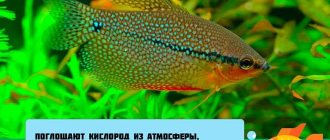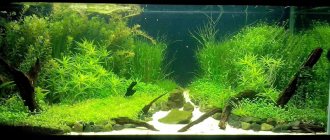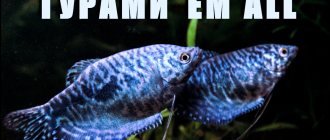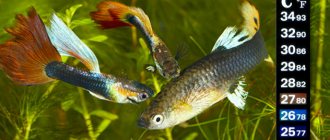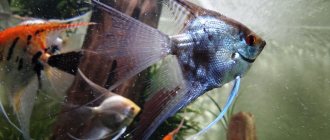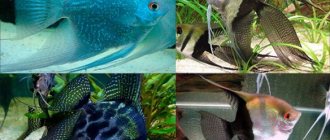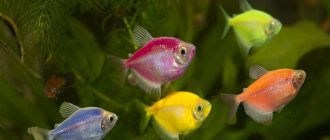General information
Among the variety of aquarium fish, it is the labyrinthine representatives that are considered one of the first pets to inhabit home artificial reservoirs. The peculiarity of these fish is the presence of a special organ, thanks to which the fish are able to breathe air. At the end of the 19th century, when the aquarium hobby began to develop, compressors did not yet exist, so the owners were mainly engaged in keeping labyrinth fish, which included thread-bearing gourami.
Translated from the Javanese dialect, the name of the agile gourami literally translates as “fish sticking its nose out of the water.” The translation reflects in detail the essence of the phenotypes, taking into account the presence of a labyrinthine respiratory organ in fish. The second feature is considered to be modified fins, which have transformed into thin, long threads, which is why the fish began to be called thread-carrying gourami. The change was not an accident - thread-like fins replace the fish's organs of touch, with the help of which the pets calmly navigate in turbid water.
Appearance
Almost all gourami are medium-sized fish, stretching up to 10-15 cm in captivity. However, there are also large varieties - serpentine and commercial, the body length of which is 25 cm and 100 cm. Attractive appearance and graceful movements have given the gourami genus extraordinary popularity. Description of appearance:
- The body is elongated, flattened at the sides.
- The pelvic fin originates from the middle of the abdomen and expands towards the tail.
- The pectoral fins are thread-like, equal to the length of the body and have the ability to regenerate.
- The dorsal fin differs depending on gender: in males it is elongated and sharp, in females it is rounded.
Interesting fact: fish dishes from commercial varieties are popular in Asia.
Marbled gourami: content
Keeping fish is easy. First, you should get 5-6 young individuals and place them in an aquarium of up to 50 liters. The lid of the aquarium should not close tightly, the distance to the water should be 5–9 cm; the fish need atmospheric breathing.
The temperatures in the aquarium and the room should be similar, since breathing cold air makes the fish sick.
As time passes, individuals should be moved to a larger location. This species is adapted to heat, accustomed to the climate of Asia, which means the temperature should be above 24 degrees.
Moderate filtration is needed. There is a need for aeration if there are other fish in the neighborhood. If gourami live separately, it is not necessary. In such a situation, you need to replace a fifth of the water after a week.
Light is needed in the upper part of the aquarium, but the morning sun should not penetrate into it.
To make the fish visible, use pebbles, coarse sand or granite chips as soil. Plant plants in it, first placing them along the edges of the space.
If breeding is planned in the future, then you need to add floating plants. They are used to create a nest. And also add a decorative structure in which gourami like to hide.
Origin story
For such an interesting phenotype as gourami, the fish’s homeland is in the tropical waters of Thailand, Vietnam and Malaysia, where agile and bright representatives of the genus calmly survived in the most unsuitable conditions:
- Rain barrels.
- Rice fields.
- Ditches and pits filled with rainwater.
Having become interested in tenacious fish, people tried to transport captured representatives to other countries, but failed. Hardy and unassuming phenotypes died on the road, so the fish were left alone. And only a couple of decades later, researchers and aquarium enthusiasts found out the cause of death of the individuals - the fish died due to lack of air. At that time, humanity did not yet know about the special structure of labyrinth fish, so shipping containers were filled with water to the brim and closed tightly, and the poor creatures suffocated. The first successful transportation of fish took place in 1896 - in a barrel 2/3 full.
The spread and breeding of gourami as an aquarium resident is closely intertwined with the name of Pierre Carbonnier, who participated in the transportation of fish. The phenotype was brought to Russia by A. S. Meshchersky, a fan of underwater depths and inhabitants. Paul Matte and V.M. Desnitsky also contributed to the history of fish.
Kinds
Gourami is an aquarium fish that is loved by aquarists due to its peacefulness, unpretentiousness and variety of varieties. Types of gourami differ from each other in size and color, and there are a great many of them, but only a few varieties can rightfully be considered popular in the aquarium hobby.
Pearl
The pearl variety is a beautiful fish that has earned a mysterious name for its excellent body color. The color of the scales of pearl representatives is silver, with lilac and violet reflections, the back is lemon-brown, the fins and sides are bluish. There are light dots on the body of the phenotype, like a scattering of pearls. Pearl fish do not exceed 10 cm in length and have a modest and friendly disposition.
Interesting fact: in their homeland, pearl representatives are listed in the Red Book.
Lunar
In the homeland of the moon gourami, fish breeding is carried out in order to prepare dishes or catch them for sale. The body length of moon gourami in an aquarium is 10-12 cm, but in natural habitats the fish grow up to 18 cm.
A distinctive feature of the lunar variety is small scales and red-orange eyes. The body is gray-blue with a clear silver tint. The female moon gourami is more modestly colored than the males of the same species. The lifespan of moonfish at home is 7 years.
Spotted
Due to its undemanding phenotype, keeping and caring for the spotted gourami will not cause any difficulties even for a beginner in the field of aquarium keeping. In a home tank, the length of spotted fish reaches 10-12 cm, the body color is bluish or light sapphire with spots and stripes.
Interesting fact: in the wild, spotted gouramis hunt prey by knocking down insects with a stream of water.
Gold
Golden gourami cannot be found in the wild, since this variety is the result of the efforts of breeders. Representatives of the species are characterized by endurance, mobility, unpretentiousness in matters of nutrition and maintenance, as well as golden color. The body of the fish is golden in color, with dark spots along the back, which makes this species extremely attractive in the eyes of fish holders.
Marble
Marble gouramis are cute and nimble fish, the color of their scales resembles marble stone. Representatives are distinguished by their large body dimensions - up to 15 cm, and are considered among the most aggressive among their relatives. When choosing neighbors for the marbled variety, you should take into account compatibility with other fish.
Grumpy
Grunting fish are an unusual phenotype that has gained fame due to the ability to make a variety of sounds similar to the croaking of baby frogs. The color of the fish is yellowish-lemon, the body is decorated with dark stripes, and the eyes are scarlet or golden-orange. Representatives grow up to 6-8 cm in length. The grumbling variety has calm and friendly phenotypes, despite the fact that the male has spine-like processes adorning the tail.
Honey
The honey variety, or coliza, is an unpretentious fish that has earned the love of aquarists due to its undemanding nature and pleasant color. The phenotype extends up to 6 cm in length, while the females are larger than the male honey gourami, and the colors of representatives of the opposite sexes are also different. The character is shy and timid, and if the fish are stressed, the color of the fish turns pale.
Kissing
The variety received its unusual name due to the strange habit of the fish: when they meet, the pets freeze and then touch their mouths. These actions are very similar to the kiss of a couple in love, which is why the fish got its nickname.
Kissing fish are easy to keep and grow up to 15 cm in length. The colors are gray or pink, the latter option is in great demand. Many aquarists are interested in how long kissing gourami live - life expectancy is 6-8 years.
Gourami species
Today, in home aquariums you can find a large number of varieties of gourami: pearl, blue, marbled, golden, kissing, moon, honey, spotted, grunting and others.
But in fact, there are only four species of the named gourami - the genus Trichogaster:
— Pearl gourami (Trichogaster leeri).
— Moon gourami (Trichogaster microlepis).
— Brown gourami (Trichogaster pectoralis) is the largest of the genus Trichogater. In an aquarium it can reach 15 centimeters in length; in nature it grows even larger. However, despite its size, it is a peaceful fish.
— Spotted gourami (Trichogaster trichopterus). The last species has many different color variations - morph: blue, yellow and white. These morphs bring some confusion to the gradation of gourami - trichogasters.
All trichogasters are close relatives of the giant game fish called gourami in Indonesia - Osphromenus goramy. By the way, they are now also keeping it in aquariums.
For their resemblance to this fish, all of its more or less large relatives with thread-like pectoral fins also began to be called “gourami” by tradition. In Javanese, "gurami" means "fish showing its nose out of the water."
A genuine gourami grows up to 1 meter. In Indonesia and Malaysia they are sold in grocery stores. And the hamsters eat them like we cutlets with hake.
In addition, it is worth noting separately that kissing gourami is not a genus of Trichogaster at all, it is a genus of Helostoma. The honey gourami itself is the genus Colisa, the grumbling gourami is the genus Trichopsis, the chocolate gourami is the genus Sphaerichthys. But all of them in the post-Soviet space are popularly called GURAMS. And also, the constant reclassification of fish adds fuel to the fire. For example, today Trichogasters are classified into Trichopodus; some biologists retain the previous nomenclature, while others use a new one. This has not yet been fully legalized. Both options are still used in parallel today. You can write it either way. However, according to the new nomenclature, all Trichogasters are now Trichopodus, and all Colyses are now Trichogasters. Below are the most popular species, morphs and false gourami.
Pearl gourami
Trichogaster leeri
The body of the pearl gourami is tall, elongated, flattened laterally. The body color is silver-violet with numerous pearlescent spots (resembling pearls), scattered not only throughout the body, but also on the fins. An uneven dark stripe runs along the entire body. The length of the pearl gourami is 11 centimeters.
The male is much larger than the female, has a brighter color, elongated dorsal and anal fins. However, there is another, very characteristic feature - the color of the neck of pearl gourami: red in the male and orange in the female. These differences appear already at a young age, but are especially pronounced in older individuals. And during the spawning period, the male’s color differences prevail: the neck and abdomen light up with a red tint, the pearls shimmer and sparkle. Therefore, identifying the sex of fish does not cause difficulties at any age.
Pearl gouramis do not tolerate transplants and “moving” to a new place well - they remain shy and pale in color for a long time.
In nature, pearl gourami lives in the reservoirs of India and Indochina, in the south of Malaysia and Thailand. In reservoirs carrying well-heated, clean water with rich, dense vegetation.
Moon gourami
Trichogaster microlepis
Currently they inhabit the rich vegetation reservoirs of Cambodia and Thailand. They were brought to Europe in 1951, and in 1981 they began to appear among aquarists in Russia.
The fish has a tall body, slightly elongated in length and compressed at the sides. The body is painted in a uniform bluish-silver color. In aquariums they usually do not exceed 12 cm, but in the wild they can reach 15 cm. Life expectancy is from 5 to 7 years.
The fish are peaceful and shy. They can be kept with almost all peaceful inhabitants of the aquarium. But it is advisable to select fish of similar size for their neighbors.
For comfortable living, the aquarium must be at least 50 cm in length, planted in places, have shelters and free space for swimming. In addition, the aquarium should have floating plants that the fish use for spawning. To highlight the beauty of this fish, it is better to use dark-colored primers.
Blue gourami
Trichogaster trichopterus sumatranus
In nature, it lives in Southeast Asia, in the waters of the island of Sumatra. It first appeared in Europe in 1958.
The blue gourami has a tall, oblong and laterally flattened body. The upper fin is high and pointed. The lower fin starts from the pectoral fin and gradually expands to end at the base of the tail. The pectoral fins have the shape of thread-like antennae. They are the gourami's sense organs and are constantly in motion. With the help of pectoral fins, fish become familiar with surrounding objects. The main body color is sea green. On the sides there are transverse blue stripes and two black spots on each side: one in the center of the body, the second on the caudal peduncle. The unpaired fins are decorated with silvery dots scattered on them. In nature, blue gourami reaches 12-14 cm in length; in an aquarium they grow up to 8-10 cm.
The blue gourami is very peaceful and gets along well with various types of fish of large and small sizes, but sometimes there are individuals that show aggression towards their relatives. Leads a daily lifestyle. It lives in the middle and upper layers of water. These fish are very interesting to watch: they are cheerful and do not miss a moment to frolic, they are curious about everything new, be it an element of decor or another fish.
Marbled gourami
Trichogaster trichopterus sumatranus
The marbled gourami is a mutation of the blue gourami. Large fish. Individuals of the marbled gourami species can reach 13 cm in length. The body is oval, high, laterally compressed. The pelvic fins are long and filamentous. The anal fin is wide. The body color is marbled: there are dark gray spots of irregular shape on a light gray background. The anal, dorsal and caudal fin are dark gray, with numerous yellow spots. The pectoral fins are transparent and colorless. The male differs from the female in having a narrower body, bright coloring with elongated, more pointed dorsal and anal fins. It is best kept in an aquarium with a volume of 50 liters+.
Golden gourami
Trichogaster trichopterus sumatranus var. Gold
In nature, it lives in reservoirs rich in vegetation on the island of Sumatra.
The golden gourami has a tall, slightly elongated and laterally compressed body. The body of the gourami is golden yellow with an orange tint. There are two dark spots on the side, one in the middle of the body, the other on the caudal peduncle. Blue spots are scattered throughout the body and fins. The male is larger and brighter than the female. It grows up to 13 cm in length. The lifespan of a fish in an aquarium with proper maintenance is up to 7 years.
The golden gourami is a peaceful, shy fish that, in case of danger, prefers to hide in dense thickets. It gets along well with various types of fish of large and small sizes, but sometimes males show aggression towards each other. They lead a diurnal lifestyle. Golden gourami stays in the upper and middle layers of water.
It is necessary to keep a golden gourami in a well-lit aquarium with a volume of at least 100 liters (for 4 fish) with thickets of living plants (including floating ones) and free space for swimming. It is desirable to have snags (the fish constantly stay near them), the soil is dark.
Gourami kissing
Helostoma temminckii
Kissing gourami inhabit Thailand and the islands of Kalimantan, Sumatra and Java. In nature, gourami lives in water bodies of India and Indochina.
The popular name of the fish “kissing” is associated with the characteristic “kissing” movements of the lips that fish make when feeding, showing aggression, and also during courtship.
The dorsal and anal fins are long and low. The fins have a greenish and sometimes yellowish tint. The color of the kissing gourami varies: gray-green, golden-pink, and yellow. There are albinos.
He is distinguished by a calm and peaceful character, a little timid. Gets along easily with non-aggressive neighbors. However, if there is not enough space, the fish can fight for territory, opening their mouths wide.
Kissing gourami can be kept in an aquarium with a capacity of at least 50 liters with densely planted vegetation; it is also necessary to have driftwood as a shelter and a free swimming area. The soil should be dark.
Content
Keeping and breeding gourami requires the owner to follow a number of rules that reflect the preferences of representatives of this genus. The aquarium for the fish is selected to be spacious, taking into account the size of the future inhabitants - the larger the species, the more space the pets will need. Optimal water parameters:
- Acidity – 6-6.8 pH.
- The water temperature for gourami is 25-28C.
- Hardness – up to 10 dH.
The parameters must be strictly observed so as not to provoke the development of gourami diseases. An artificial reservoir must be equipped with a lid, leaving empty space between it and the water surface, filter and compressor. Flora is planted alive so that the fish feel calm and protected, and can hide in the thick of the plants. The soil is chosen to be dark in color, and the lighting is moderately intense, which will highlight the color of the pets.
Fish care includes weekly renewal of 30% of the volume, cleaning and cleaning of the tank, substrate siphon.
What type of aquarium is needed?
Fish need to create conditions that resemble their natural habitat. An aquarium for 3 or 5 individuals should have a minimum volume of 40 liters. The more fish, the larger the container should be. Pour in warm and not hard water. Temperature is from 24.5 to 28.5 degrees, hardness is 9-20 pH, and acidity is from 6.50 to 7.50 dH.
Select the soil in dark tones, the fraction is not important. Plant more vegetation in your aquarium, but be sure to leave room in the middle for the gourami fish to move around. You can use, for example, cryptocorynes, cirrus, and Thai fern. Plants help fish calm down and have privacy.
We recommend reading
About the reproduction of Ancistrus catfish
Also, install a variety of hiding places in the aquarium for swimming fish. Driftwood, stones, clay pots and coconut shells are suitable for this purpose. Place any floating plants on the water, for example, watercolor, riccia, pistia. If there is a lot of algae and hiding places in the aquarium, the fish do not experience stress, because in their homeland they live in muddy, shallow water. They can rest peacefully in thickets of plants.
Compatibility
These labyrinth fish have a peaceful character, so gouramis show good compatibility. Pets get along well with the following species:
- Neons, minors and rasboras.
- Angelfish, tetras, labeo.
- Catfish, apistogramma, platies.
- Rainbowfish, zebrafish, molly.
You should be careful with small fish - for example, gourami and guppies have average compatibility, despite the fact that both species are peaceful. Gourami has negative compatibility with the following species:
- Sumatran barbs and swordtails.
- Parrots, goldfish.
- Cockerels, astronotuses.
Gourami compatibility
Gourami are very peaceful and calm fish that can easily make friends with all other peaceful species of fish (botia, lalius, thorns, etc.). However, it is worth remembering that very fast fish species (such as swordtails and barbs) love to chase the gourami's whiskers. When choosing neighbors, you should also remember that gouramis are soft-water and acidic fish, that is, they prefer pH and dH below 7. It is advisable to maintain these comfortable water parameters for the gouramis themselves and select the same soft-water neighbors.
Feeding
Having purchased colorful fish, novice aquarists are at a loss as to what to feed gourami in captivity. As in their maintenance, gourami are unpretentious in nutrition, so they happily eat the following foods:
- Dry food.
- Plant food.
- Live food: daphnia, tubifex, bloodworms.
The main thing is that the diet is balanced, and if gourami spawning is planned, then the portion of live food is increased. Feeding is done 1-2 times a day, giving small portions. It is important to note that these fish are able to endure a five-day hunger strike without consequences.
What species do they get along with?
Fish of the same size as the marbled gourami can live peacefully together with it, since larger individuals suppress it, and smaller ones can become the object of aggressive behavior. You can keep several gouramis in an aquarium, then clashes between males will be minimized.
We suggest you familiarize yourself with: Sheep in Ukraine are the main breeds
Every gourami should have a pair, then the fish live in families and rarely conflict. Good compatibility can be provided by neons, irises, loaches, corydoras catfishes, zebrafish, minors, swordtails, angelfish, barbs, koi carps, lapius, and plecostomus catfishes. These fish have a calm disposition, a balanced character, are not malicious towards their neighbors, and prefer a quiet, measured lifestyle.
Angelfish, macropods, lalius and thornets may also live together with gouramis.
In one artificially created reservoir, if it is quite spacious, you can contain several species of fish that are compatible with each other and differ in the same maintenance parameters. When adding other species to gourami, you need to think about how and where they will spawn and build nests for their offspring. To do this, it is necessary to create suitable conditions.
Gourami has average compatibility with discus and eels. Under proper conditions, these species can live well together.
Reproduction
When keeping gourami, fish breeding can begin from the moment the pets are 8-12 months old - at this age the phenotypes reach maturity.
To reproduce, you should know how to determine the sex of fish. How to distinguish a female from a male:
- The color of boys is more intense during the spawning period than that of girls.
- In males, the dorsal fin is long and with a sharp tip, in females it is short and rounded.
Before pregnancy occurs, the owner needs to prepare a spawning tank with a volume of 20-30 liters with live vegetation and shelters. 14 days before spawning, the fish are intensively fed with live food, and spawning itself is stimulated by increasing the temperature.
A caring parent builds a nest for eggs, after which the pregnant gourami lays eggs, and the male puts them in the nest.
After the gourami fry are born, the father is returned to the old house. Gourami fry should be fed ciliates and zooplankton. After 2-3 weeks, the babies will develop a labyrinthine organ, and until this point the spawning tank is equipped with an aerator.
Breeding
Breeding gourami is a simple process; you just need to know when they are ready to breed and where to place them during the spawning period. Of course, the best way to acquire fry is to install a separate spawning tank. Raising the temperature in it to 28-29 degrees, bringing the hardness to 10o, the acidity of the water to pH 6.5-7.0. For several weeks before spawning, you need to feed a couple of fish with live food containing protein. A few weeks after preparation, the female will become round and eggs will develop in her. Next, the breeders are released into an aquarium with clean water, but not a strong current. The tank should have floating plants and shelters. In labyrinths, it is usually the male who builds the nest, and he also takes care of the eggs. Some species are distinguished by peculiar premarital behavior, but often the breeding rules are general. The male builds a nest from bubbles and plants, holding the “structure” together with saliva.
During spawning, fish may make sounds reminiscent of the purring or croaking of frogs. This is a consequence of the work of the labyrinthine organ located under the gills. The male invites the female to his nest and begins to dance with her, helping her to free herself from the eggs. Then he fertilizes it and transfers it to the nest, returning the fallen eggs to their place. Some representatives of gourami produce 200-300 eggs, the female serpentine - up to 1000 eggs or more. The incubation period is from 24 to 72 hours depending on the water temperature.
After spawning, the female can be removed immediately, and the male can be left until the fry hatch. First, they eat the contents of the yolk sac, and later they will begin to swim on their own in search of small food. Starter food – ciliates, liquid food for fry. Later you can give brine shrimp larvae, but make sure they are small. Babies also need access to atmospheric oxygen for the proper development of the labyrinthine organ. Fish become sexually mature at the age of 6-12 months.
What do gourami suffer from?
This rarely happens. They can become infected from already sick fish or suffer due to poor nutrition. Patients need to be isolated. The most common diseases are:
- Lymphocytosis. Open wounds, nodules and swelling appear on the body, and a flour coating forms.
- Pseudomonosis. It appears as darkened spots, gradually turning into ulcers.
- Aeromonosis. The reason is overpopulation of the aquarium. Signs: refusal to eat, sinking to the bottom, ruffled scales, swollen and bleeding abdomen.
Diseases
Despite the endurance and unpretentiousness of the fish, gourami is often plagued by diseases. If the fish lies on the bottom or refuses food, then these are sure signs of an approaching illness. The most common diseases in gourami are:
- Dropsy - develops due to a lack of oxygen in the tank. The situation can be corrected by improving the aeration of the reservoir.
- Invasive diseases - hexamitosis and ichthyosporidiosis. Infected pets become restless, gourami fish rub against the surface, and body weight decreases.
- Lymphocystosis - develops as a result of infection with parasites or due to mechanical damage. Treatment is usually not required, and recovered pets acquire immunity.
- Ligulosis - the cause of infection is poor-quality food. If a gourami has a swollen belly and loss of appetite, then most likely it is ligulosis.
- Aeromonosis is a characteristic disease of pearl gourami, which occurs when a reservoir is overpopulated. The symptoms of aeromonosis are as follows: the scales become ruffled, the pet loses weight, lies on the bottom from powerlessness.
Gourami are cheerful and active fish, which are a pleasure to keep. Unpretentiousness, abundance of species and colors, peacefulness are only a small part of the advantages for which aquarists love gourami species, and nimble and nimble pets pay their owners the same.
What do they get sick with and why?
Unfortunately, fish sometimes get sick. There are organisms that cause various diseases in gourami. In a short time they are able to infect all inhabitants of the reservoir.
Diseases affecting pets:
Lymphocystosis is a serious disease, easily identified by open wounds, grayish nodes or black growths that appear on the body. The skin around the formations rises slightly. Usually, sick fish looks like it has been sprinkled with semolina. People call this disease “semolina”.
pseudomonosis - the disease makes itself felt with darkish spots that quickly turn into red sores. Through them you can “catch” an infection.
aeromonosis - this disease gets to the fish along with food. At first, frail fish in densely populated aquariums get sick. The first sign is that the scales are bristling. Then the fish stop eating, become almost motionless, and lie down on the bottom. Their tummy swells and there are blood stains on it. If your pet is treated, he can make a full recovery.
We recommend reading
About marbled gourami

